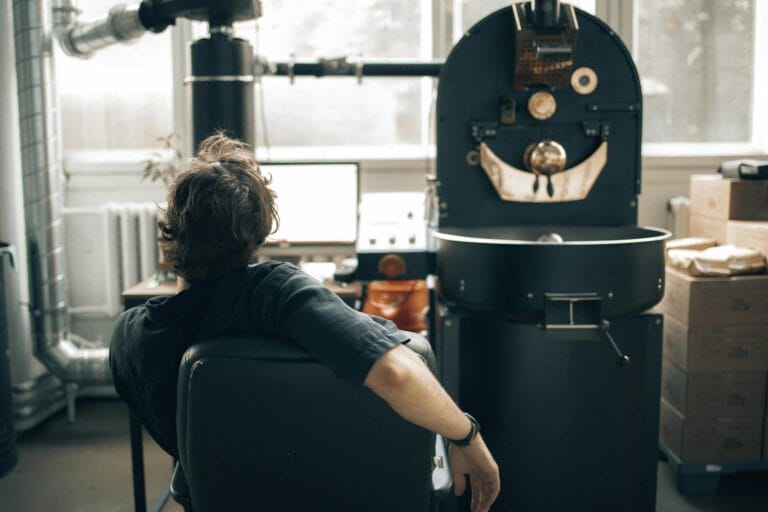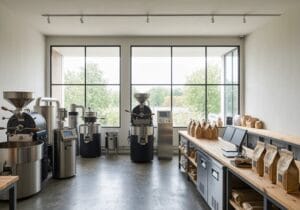New roasters, listen up! If you wanna impress friends with your coffee skills, start with three flavors: floral and bright (think jasmine and lavender—so invigorating!), balanced sweetness (like a cozy croissant), and bold sweetness with a twist (dark chocolate meets nutty goodness). It’s like a rollercoaster for your taste buds! Remember, quality beans are the secret sauce to making these flavors pop. Stick around for tips on how to nail these tasty profiles like a pro!
Key Takeaways
- Floral profiles from Ethiopian Arabica beans provide bright, aromatic flavors ideal for new roasters to explore without complex techniques.
- Balanced sweetness can be achieved with medium roasts, showcasing origin flavors while retaining clarity and sweetness.
- Bold sweetness from medium-dark roasts, like those from Peru, adds depth and complexity, appealing to varied taste preferences.
- Consistent roasting techniques, focusing on the Maillard and caramelization stages, help new roasters achieve desirable flavor profiles reliably.
- Selecting high-quality beans enhances flavor retention and complexity, setting a strong foundation for successful roasting outcomes.
Floral and Bright Profiles
Floral and bright coffee profiles, surprisingly enough, frequently catch many new roasters off guard, like a sudden downpour at an outdoor picnic!
Imagine this: you open a bag of beans and suddenly, bam, it’s like walking through a garden! Those floral aromas—think jasmine, rose, and lavender—can be tricky. They pop out at you more in smell than taste, and trust me, if you roast too dark, those delicate notes go poof! This is why it’s crucial to select high-quality Arabica beans that can highlight these flavors without fading. The genetic diversity of Ethiopian landraces contributes to their high cup quality, making them excellent choices for achieving those floral notes.
It’s all about the brewing methods, folks. Use a pour-over or Aeropress, and keep that water temperature just right (195-205°F, if you’re writing it down!). The processing method you choose can significantly impact the presence and intensity of those floral notes in your cup.
And don’t forget, high-quality Arabica beans from Ethiopia and Panama can give you those prized floral characteristics. Who knew coffee could be so flowery?!
Balanced Sweetness and Clarity
In regard to coffee, striking that perfect balance between sweetness and clarity can feel like trying to walk a tightrope while juggling flaming torches—exciting but a little terrifying!
New roasters often grapple with how much sweetness to coax out of their beans without dimming the brightness.
- Maillard development kicks in early, weaving those delicious flavors like a fine tapestry.
- Caramelization adds that dreamy buttery sweetness—think of a warm croissant right out of the oven.
- Medium roasts shine here, showcasing origin flavors while wrapping them in a cozy blanket of sweetness. As the Typica group contributes significantly to various coffee profiles, this diversity can enhance the sweetness in the cup.
- Vigilance during the roasting process keeps those burnt notes at bay, preserving clarity.
With practice, new roasters can achieve that sweet spot—literally! Additionally, understanding how environmental terroir influences flavor compound development can guide roasters in selecting beans that resonate with their desired profiles.
Bold Sweetness With Complexity

When diving into the world of bold sweetness with complexity, one might feel like they’re trying to solve a Rubik’s Cube while riding a roller coaster—exciting, disorienting, but oh-so-rewarding once you figure it out!
To nail that medium-dark origins vibe, coffee from Peru or Nicaragua is a great start. They’re like the personal trainers of coffee—pushing those bold flavors and flavor layering to the max. Think dark chocolate meets caramelized goodness, where nutty undertones join the party. Seriously, it’s a flavor fiesta! To achieve this complexity, one can experiment with caffeine impact while brewing to balance those robust flavors effectively.
Oh, and don’t forget the Yellow Bourbon varietals; those sweet little beans make every sip sing with fruity magic. Notably, the sensory evaluation of these varieties enhances the nuanced experience of enjoying their complex flavors.
Just remember: with great coffee power comes great coffee responsibility. So, keep experimenting!
Frequently Asked Questions
How Do I Choose the Right Beans for Roasting?
To choose the right beans for roasting, one should consider bean origins that offer forgiving flavor notes. Selecting smooth Arabica beans from Central America or Brazil guarantees manageable roasting and enjoyable flavors for beginners.
What Equipment Is Essential for New Coffee Roasters?
Essential equipment for new coffee roasters includes different roaster types, such as gas and electric models, along with dependable temperature control tools. These components guarantee consistency and quality throughout the roasting process for ideal results.
How Do Roasting Times Affect Flavor Profiles?
Roasting times greatly affect flavor profiles, as numerous roasting techniques impact flavor development. Shorter times yield bright acidity and fruity notes, while longer durations produce smoother, fuller flavors with reduced acidity and increased sweetness.
Can I Mix Different Coffee Beans for Unique Flavors?
Yes, mixing different coffee beans allows for unique flavor combinations by blending contrasting or complementary bean origins. This improves complexity, enabling roasters to create distinctive profiles that single-origin coffees may not achieve alone.
What Storage Methods Preserve Roasted Coffee Freshness?
To preserve roasted coffee freshness, vacuum sealing is essential for eliminating air exposure, while humidity control prevents moisture damage. These methods markedly improve the longevity and flavor integrity of the coffee beans stored.
References
- https://coffeefactz.com/best-coffee-roasters-guide/
- https://www.sanfranroaster.com/blog/trends-in-coffee-beans-from-fading-stars-to-rising-favorites
- https://perfectdailygrind.com/2025/08/roasters-capitalise-on-trends-focus-on-specialty/
- https://freshcup.com/experts-share-emerging-coffee-industry-trends-of-2024/





